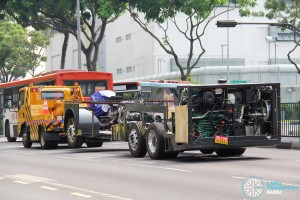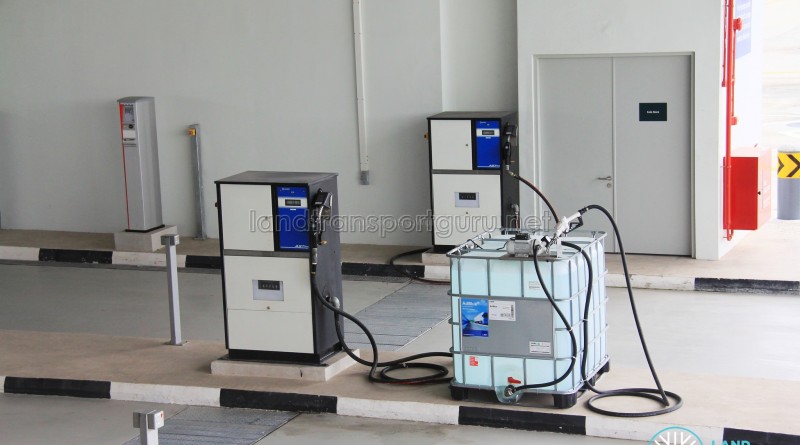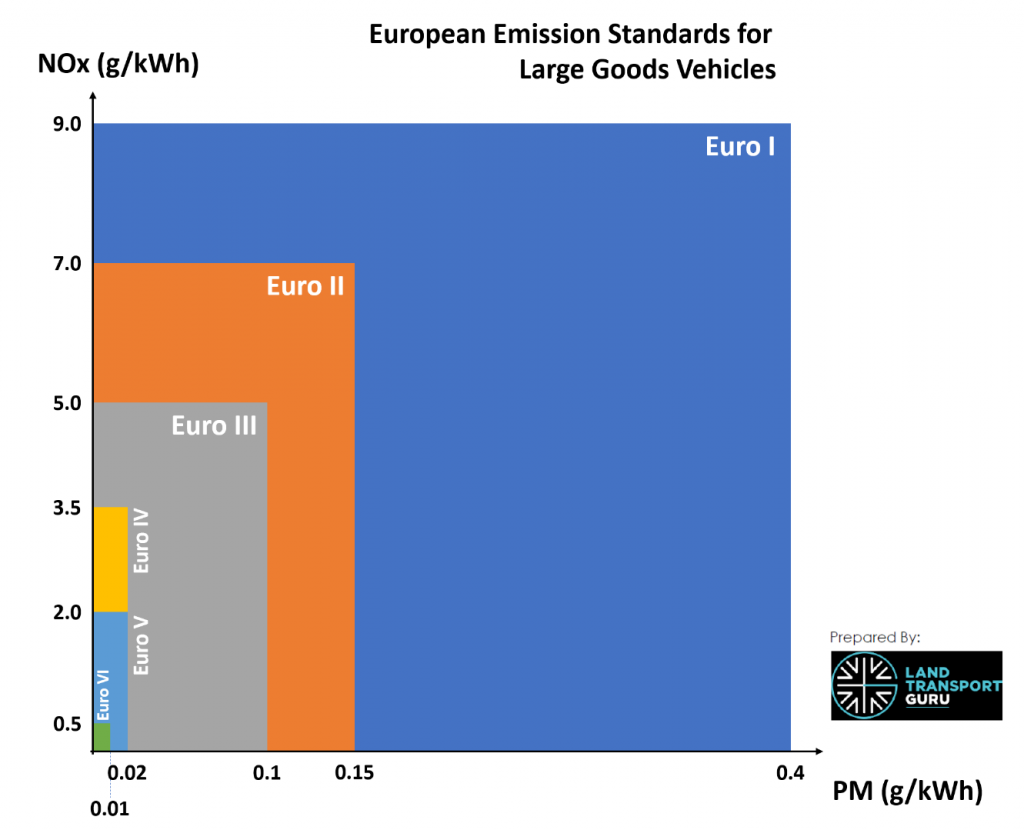European emission standards define the acceptable limits for exhaust emissions of new vehicles sold in EU member states. It has also been progressively implemented in Singapore as a standard measurement for vehicle emissions.
Introduction:

The EU separates diesel engines into three categories, namely Light Duty Vehicles, Heavy Duty Vehicles and Nonroad Diesel Engines. Different emission standards apply to each category. Buses fall under Heavy Duty Vehicles under EU classification.
EU emission standards for heavy-duty vehicles came into effect in 1988 (Directive 88/77/EEC), and subsequently implemented in 1992 as Euro I, followed by Euro II in 1996. In 1999, more stringent standards were drawn up (Directive 1999/96/EC) leading to the implementation of Euro III, IV and V standards in 2000, 2005 and 2008 respectively. Increasingly stringent Euro VI standards under Regulation 595/2009 came into effect in end-2013. In addition, the EU developed new emission testing procedures to enhance accuracy of measurements.
Emission parameters:
European emission standards combat four main pollutants in vehicle emissions – Carbon Monoxide (CO), Nitrogen Oxides (NOx), Hydrocarbons (HC) and Particulate Matter smaller than 10 microns (PM10).
- Carbon Monoxide (CO) competes with oxygen in the bloodstream, reducing available oxygen in the body. Frequently causes accidental CO poisoning and especially dangerous for individuals with heart conditions.
- Nitrogen Oxides (NOx) react with substances in the environment and forms toxic compounds. Aggravates respiratory conditions, causes smog, contributes to acid rain, and are considered greenhouse gases.
- Hydrocarbons (HC) are the leading cause of smog and are potentially carcinogenic.
- Particulate Matter (PM) affect respiratory functions and are potentially carcinogenic.
EU Emission Standards for Heavy Vehicle Diesel Engines in g/kWh (smoke in m−1):
| Tier | EU date | SG date | Test cycle | CO | HC | NOx | PM | Smoke |
| Euro I | 1992, < 85 kW | Jul 1998 | ECE R-49 |
4.5 | 1.1 | 8.0 | 0.612 | |
| 1992, > 85 kW | 4.5 | 1.1 | 8.0 | 0.36 | ||||
| Euro II | October 1996 | — | 4.0 | 1.1 | 7.0 | 0.25 | ||
| October 1998 | 4.0 | 1.1 | 7.0 | 0.15 | ||||
| Euro III | October 2000 | 2001 | ESC & ELR | 2.1 | 0.66 | 5.0 | 0.10 | 0.8 |
| Euro IV | October 2005 | 1 Oct 2006 | 1.5 | 0.46 | 3.5 | 0.02 | 0.5 | |
| Euro V | 1 Oct 2008 | 1 Jan 2014 | 1.5 | 0.46 | 2.0 | 0.02 | 0.5 | |
| Euro VI | 31 Dec 2013 | 1 Jan 2018 | 1.5 | 0.13 | 0.4 | 0.01 |
From 1 January 2018, all newly registered heavy vehicles in Singapore must adhere to the Euro VI emission standards. ESC and ELR test cycles refer to the European Stationary Cycle and the European Load Response, which test for engine emissions under varying engine speeds and vehicle loading parameters. More information can be found in the external links.
Currently, the standards for petrol and diesel vehicles here are both at Euro VI.
Public Buses in Singapore:
Buses in Singapore fall under different Euro tiers generally based on their year of introduction. More modern buses are rated at higher Euro tiers as more low-emissions technology appear on the market.
| Euro I | Volvo Olympian, Volvo B10M Mark IV, Mercedes-Benz O405, Mercedes-Benz O405G (Hispano MkI and MkII, some Habit), DAF SB220, Scania L113CRL |
| Euro II | Volvo B10TL, Volvo B10BLE (Diesel), Dennis Trident, Dennis Lance, Mercedes-Benz O405G (Hispano Habit & Volgren), Scania L94UB |
| Euro III | Volvo B9TL (CDGE) |
| Euro IV | Volvo B7RLE, Volvo B10BLE (CNG), Scania K230UB (501 units), Scania K310UD |
| Euro V | Volvo B9TL (Wright & Gemilang), Scania K230UB (600 units), Mercedes-Benz OC500LE, Mercedes-Benz Citaro, MAN NL323F (A22), MAN NG363F (A24), MAN ND323F (A95) |
| Euro VI | MAN NL323F (A22), MAN ND323F (A95), Volvo B8L, Volvo B5LH, Alexander Dennis Enviro500 (3-Doors), MAN A95 (3 Doors) |
Euro V buses use either of two emissions control technology available: Exhaust Gas Recirculation (EGR) and Selective Catalytic Reduction (SCR). More information on either can be found in their respective articles.
Euro VI engines typically combine EGR and SCR technology to meet emission requirements.
See also: Exhaust Gas Recirculation (EGR); Selective Catalytic Reduction (SCR)
Gallery:
See Also:
External Links & References:
- European emission standards – Wikipedia
- ECE R49 Emission Test Cycle – DieselNet
- ELR Emission Test Cycle – DieselNet
- ESC Emission Test Cycle – DieselNet
- Singapore Air Quality – Budget 2013
- Emission Standards – Implatz
Back to Bus Services
Back to Bus Articles

